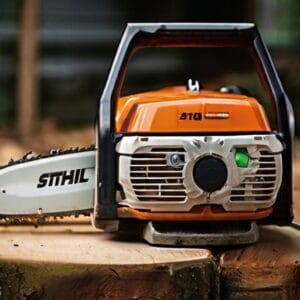Hello! Today, I’ll talk to you about an exciting topic: the Stihl 010, a 37cc light-duty chainsaw! You may have heard the story of this small but powerful tool.
Let’s dive right in: The Stihl 010 is a unique chainsaw manufactured between 1978 and 1985. During our conversation, I had a brief chat with its owner, Wesley Green. Wesley has been using this chainsaw for a few years and took all the images featured in this post. He purchased the saw in poor condition, cleaned it up, and got it running smoothly again.
The Stihl 010 and the Stihl 011 (which I also own) are essentially the same saw. They share the same appearance, and most of their parts are interchangeable. However, the 011 boasts slightly more power with its 41cc engine.
Yes, this small chainsaw can accomplish big tasks!

The Stihl 010 Saw
Back when the Stihl 010 was freshly available, Stihl labeled it as an “occasional use saw.” This chainsaw came in two versions: the 010 AV and the 010 AV-Q. The ‘Q’ designation signified that the saw was equipped with a chain brake system, a feature that has become standard on Stihl saws for quite some time now. For more detailed information on this, you can refer to our post on Electronic Quickstart.
The recommended bar sizes for the saw are 12, 14, and 16 inches (30, 35, and 40 cm), making it ideal for light pruning, limbing, and cleanup tasks. It’s not the go-to choice for cutting firewood unless you’re mainly dealing with thinner branches. Nevertheless, it can handle occasional tasks like felling small trees.
Weighing in at 9.9 lbs, the Stihl 010 is lightweight enough to be used continuously for hours. However, if you require a saw for extended use throughout the day, you might want to opt for a more powerful model.
There’s a rumor circulating that the 009, 010, and 011 saws were the only chainsaws that Stihl allowed Americans to engineer. Some jest that this might explain why they’re considered more challenging to work on!
Stihl 010 Specs
Let’s delve into the specifications of the Stihl 010:
- Engine Displacement: 37 cc/2.26 cu. in.
- Weight: 9.9 lbs/4.5 kgs
- Bar Length: 12 – 16″/30 – 40 cm
- Oil Tank Capacity: 0.24 L/0.51 pint
- Fuel Capacity: 0.25 L/0.53 pint
- Spark Plug: Bosch WSR 6 F, Champion RCJ 6 Y
- Air Filter: Felt mat
- Ignition System: Breaker-controlled magneto ignition
This chainsaw boasts standard features typical of its era, including an anti-vibration system (indicated by the AV designation), a front hand guard, and an automatic oiler.
For enthusiasts of vintage diagrams, we’ve provided a breakdown of the parts of the 010.
As previously mentioned, the Stihl 010 bears striking resemblance to the 011 model. Additionally, it shares components with the 009 and 012 models from the same era.

Stihl 010 Review
The Stihl 010 holds a notable place among chainsaws, though it’s not particularly outstanding. As one of the more budget-friendly options in the Stihl lineup, it typically sells for anywhere between $50 and $100, with some lucky finds going for as low as $20 at yard sales – a steal if you come across one at that price.
One reason for its affordability is the challenge in finding certain parts, such as oil pump diaphragms, which can be quite elusive. User feedback from various online sources reflects a mixed sentiment towards the 010:
- Some praise its reliability and usefulness, using it frequently for various tasks.
- Others highlight its effectiveness until encountering issues with parts like the oil pump diaphragm, which are no longer readily available.
- Despite its limitations, many users still regard it as a good, dependable chainsaw.
Overall, the Stihl 010 is held in high regard within its niche. However, it does come with some expected drawbacks:
- Finding replacement parts can be a hassle, with items like oil pumps, diaphragms, and fuel lines being in short supply.
- Compared to more modern models, its power-to-weight ratio isn’t as impressive.
- Additionally, the 009, 010, 011, and 012 models are notoriously trickier to disassemble and service.
Given their age and typical usage history, these saws often develop issues over time, requiring more frequent maintenance and sometimes proving challenging to start. Yet, for enthusiasts, these inconveniences are a small price to pay for the nostalgia and historical significance they offer.
On a personal note, I’ve observed firsthand the high emissions produced by my 011 model. Transitioning from a modern homeowner saw to one designed in the ’70s highlights the stark contrast in emissions output. While older models may emit more fumes, there’s a distinct charm in their sound that modern saws often lack.
